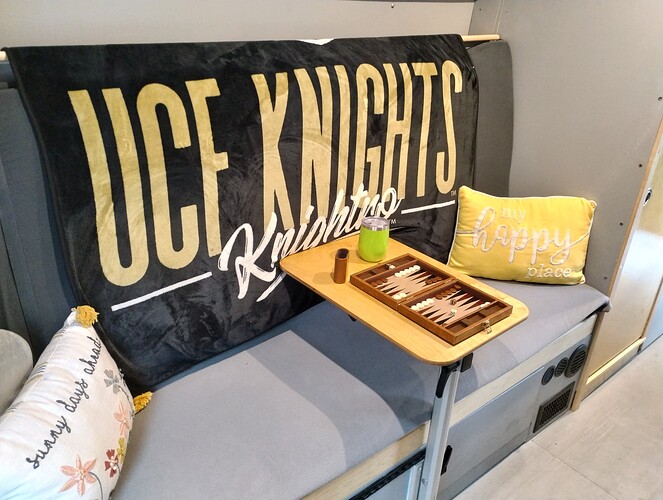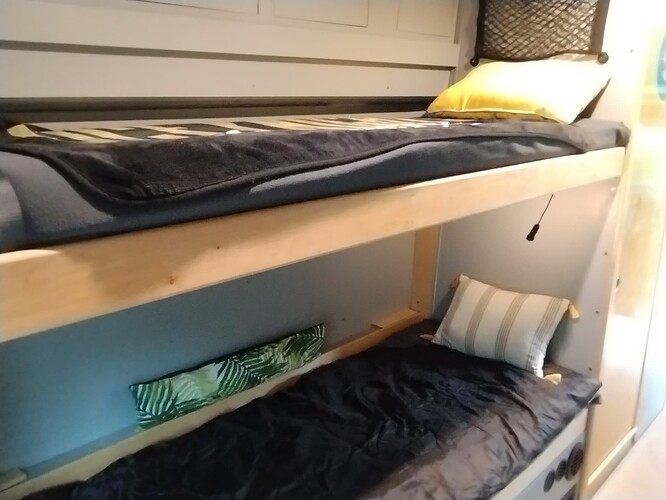Sunny days begin with restful nights! Good Sleep is incredibly important. We spend a third of our lives in bed, so the support and comfort of this piece of furniture is more important than the car seats you’ll be using on long travel days! Experts still don’t know exactly what happens when we sleep, but here’s what we do know. In order to feel rested and refreshed in the morning, we need to pass through all the distinct stages and remain in each stage long enough to benefit. Discomfort disrupts sleep.
We designed Sunny Side Up (our camper van) with space optimization in mind. Having a big bed dominate our limited space we thought would be counter productive. We settled on bunk beds that fully reconfigure at will! Most of the time, Sunny has a sofa in rear that runs front to back across from the galley leaving the center aisle clear. The top bunk detaches from the front sides and pivots down to make the back of the sofa. The bottom bunk makes the seat of the sofa. Matt designed a special cuddle-bunk that also folds out of the bottom bunk to widen the berth to accommodate two sleepers - but that’s a separate topic!
At bedtime, a single person can lift and swing the top bunk into place sliding the bolts in each corner securely into place. Each bunk is 74” by 28” which is narrower than any standard mattress. It is however, the size of a standard sleeping bag.
If you are thinking about buying a mattress for your RV Here is a table of standard mattress sizes and standard RV sizes. The main difference between an RV-rated mattress and a standard household mattress is flame retardant. At one time, RV mattresses required it and household did not. The standards have changed and now all mattresses can only be sold with flame retardant. Long story short, if a standard size fits, don’t pay extra for an “RV” mattress. Keep in mind that whatever mattress you choose, your bedding will need to match or be altered.
Most common RV mattress sizes
| RV Mattress | Size |
|---|---|
| Three quarter size | 48" x 75" |
| RV Full | 53" x 75" |
| Short Queen | 60" x 74" |
| RV Queen | 60" x 80" |
| Olympic Queen | 66 x 80" |
| RV King | 72" x 75" |
| RV Twin | 38" x 75" |
| RV Twin XL | 38" x 80" |
| Standard Mattress | Size |
|---|---|
| California King | 72" x 84" |
| King | 76" x 80" |
| Queen | 60" x 80" |
| Full | 54" x 75" |
| Twin XL | 38" x 80" |
| Twin | 38" x 75" |
The solution for me was obvious. First we need a word about Sleep Number adjustable mattress construction.These mattresses are adjustable for firmness using a pair of air chambers* attached to a pump that runs on household 110v electricity. You can control it with either a hand-held remote (AA batteries) or an app on your phone (Bluetooth). New pumps have fancier features but require WiFi.
Every mattress unzippers. After you peel back the cover (some of these are padded), inside you will find various foam and cushion layers. Early models have separate pieces for the top, sometimes bottom and side walls. This makes the mattress look and feel traditional when its all zipped together and you can sit on the edge comfortably. Later models have a single “tub” of foam with the top and sides glued together. Different models have different foams with various densities and materials. Some of the layers dissipate heat better than others.
We bought a used, queen size Sleep Number mattress to take apart. If you are buying old or used mattresses, take a good look at the foam layers before using them. Foam degrades depending upon age, use and environment. If it isn’t flexible with good spring back - don’t use it. You can acquire foam pieces elsewhere if necessary. The magic is in the air chamber and pump.
The air chambers inside Sleep Number mattresses are naturally smaller than the mattress itself to accommodate the foam inserts. Queen and full or double size all have the same size air chambers inside. King and Twin XL have the same size chambers as each other. Regular Twin and Cal King are harder to find and will be different.
The queen air chamber is 74” long and 26: wide. By a stroke of luck, I discovered that an oversized sleeping bag was the PERFECT SIZE to accommodate one air chamber plus a 1” foam pad that we pulled from the queen mattress. As a bonus, the open end of the ones I bought had a draw string to constrict about the face like a mummy bag. That left room for the hose to come out then cinch closed - No sewing required!
Because the top bunk swings vertical, we added straps to hold the mattress in place for the sofa configuration. A quick note about the hoses. Older models of SN mattresses have the hose connection at the end of the mattress. More recent models have the hose coming off the mid-point of the side. The end hoses are perfect for us. We have them route to the corner of the bed for the top one it’s one of the pivot corners.
Both hoses connect to the pump which Matt installed under the bottom bunk giving it a 110 outlet. In the event that someone needs a CPAP machine or other device for sleep, there is an open socket.
How to use Sleep Number: Step One, pump up both sides the bed (I renamed mine top and bottom) to 100. This is not PSI it represents max inflation. Step Two, lie down on your bunk. Step Three lower the number and feel the contour until it’s comfortable. Try your favorite sleeping positions. Remember that you can always change the number depending upon who’s in the bed or how you might be feeling.
Sweet Dreams!
Rosellen Kraus is a Sleep Professional at a Sleep Number store in Florida. She helps people find the right mattress and does custom pillow-fits too!
- In case you are worried about the air chambers breaking like a pool float or camping mattress, note that these are 24 gauge vulcanized rubber. Like a Zodiac-style boat, they can withstand up to 1000 lbs of pressure without rupturing. There are 18 baffles inside that distribute the air keeping your spine always aligned. The weakest spot is the hose and hose connection which can be easily replaced.

